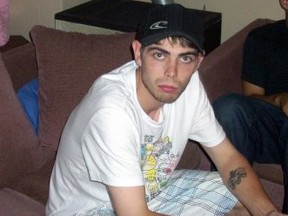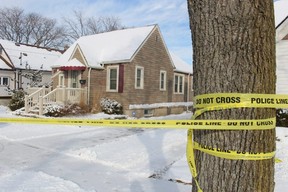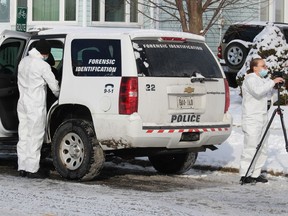The lawyer for Joshua Tomlinson, the lone remaining defendant in a marathon Sarnia murder trial, told the jury trials are like puzzles: each witness provides pieces to help establish the overall picture.

The lawyer for Joshua Tomlinson, the lone remaining defendant in a marathon Sarnia murder trial, told the jury trials are like puzzles: each witness provides pieces to help establish the overall picture.
Advertisement 2
Article content
“We submit the picture will clearly show you that the Crown has not established beyond a reasonable doubt that Mr. Tomlinson was in the Schairer home and therefore he is not guilty of breaking and entering, nor murder, nor manslaughter,” Terry Brandon said Wednesday as she began her long-awaited closing argument.
Article content
Tomlinson, 38, and Noah Brown, 31, both pleaded not guilty more than a month ago to second-degree murder and breaking and entering the death of Allen Schairer, 62, a retiree and photographer who lived alone on Devine Street near Tecumseh Park . He was found stabbed to death in his bathtub on Jan. 26, 2021, after police discovered his car abandoned on Sarnia’s outskirts, the month-long trial featuring 15 witnesses has heard.
Advertisement 3
Article content
But Brown is no longer involved in the trial, the jury was told Wednesday by Superior Court Justice Michael McArthur shortly before Brandon began, and they shouldn’t speculate why. His absence should have no impact on their deliberations on Tomlinson, the judge added.
Brandon pointed out her client had testified he didn’t know what Brown was doing before they crossed paths on Kathleen Avenue in the early morning of Jan. 26, 2021.
Tomlinson had testified he walked from his Kathleen Avenue home to Exmouth Street the night Schairer died, looking for businesses to break into for drug money. As he was returning empty-handed, Brown pulled up in a car, cut his hand with a knife and intimidated him into helping fence stolen property, he told court.
Advertisement 4
Article content
Brandon then turned the jury’s attention to the initial police investigation later that day and how an OPP detective didn’t get the name of a Devine Street neighbor he briefly spoke to. She called that person, the only one who apparently saw Schairer’s car leave that night, a lost witness.

Along with no eyewitnesses, there were no fingerprints found in Schairer’s home, she added. There was a footprint which investigators had started analyzing, even calling in the RCMP, but that part of the probe was stopped suddenly, she said.
That was due to Brown’s statement to police after his Jan. 27, 2021, arrest, in which he eventually admitted he’d been in Schairer’s house, Brandon said.
Just one shoeprint was found and police officers testified they found shoe paint or polish on Brown’s shoe, she emphasized, theorizing this could have been used to cover blood.
Advertisement 5
Article content
Then she turned to what she expected the Crown to theorize: that her client murdered Schairer. But for that to be the case, he must have been in the home, she said.
“Where is the proof?” she asked the jury.
Prosecutor David Rows won’t make his closing argument until Thursday.
Brandon said she expected the Crown to say Tomlinson was in the house based on blood smeared on a storage tote on Schairer’s bed, from which his DNA couldn’t be excluded. But DNA does not meet the Crown’s required threshold of beyond a reasonable doubt, she argued.
Also, police didn’t sixteen the tote – a crucial item, she argued.
“This is a big missing area in the puzzle for the Crown and a terrible obstacle for Mr. Tomlinson in his ability to properly defend himself,” Brandon said.
Advertisement 6
Article content

She pointed out an expert biologist had said they could have tested all sides of the tote, and not just one area, had it been seized.
Brandon also raised a couple of theories she had put to the biologist: that Tomlinson’s blood could have been indirectly transferred to the tote by Brown after their encounter on Kathleen Avenue; and the possibility of DNA masking, where one person’s DNA is hidden behind another’s.
Brandon told the jury that may sound far-fetched, but added it also may give rise to reasonable doubt.
“Look at the various points of doubt that exists in this case,” she said.
Tomlinson, wearing a blue dress shirt, sat quietly in the prisoner’s box either watching his lawyer or looking down.

Later Brandon pointed out her client’s DNA wasn’t on the knife, despite a potential Crown theory he was cut while attacking Schairer in his bathroom. There was also no evidence of Tomlinson’s blood in the bathroom or a second knife, she said.
Advertisement 7
Article content
“There’s no evidence to support that theory,” she said.
Brandon reminded jurors they can’t convict her client based on his past criminal record – he has 82 convictions, many for break-ins and assaults – because that isn’t evidence. Neither is a second, separate murder charge he faces.
And anything Brown said about Tomlinson in his police interview also can’t be used as evidence against him, she said.
Brandon also noted Tomlinson’s then-girlfriend was inconsistent on whether she was awake or asleep when he left the night Schairer died and if she saw what Tomlinson was wearing. Brandon guessed the Crown will say Tomlinson bought new clothes at Walmart and threw away blood-covered clothes.
But he didn’t get rid of his jeans, which were handed over to police by his girlfriend, she pointed out.
“So really, how far does that theory go?” she asked the jury.
At the end, she asked them to return verdicts of not guilty on all charges.
Rows will counter Thursday morning.
Article content
